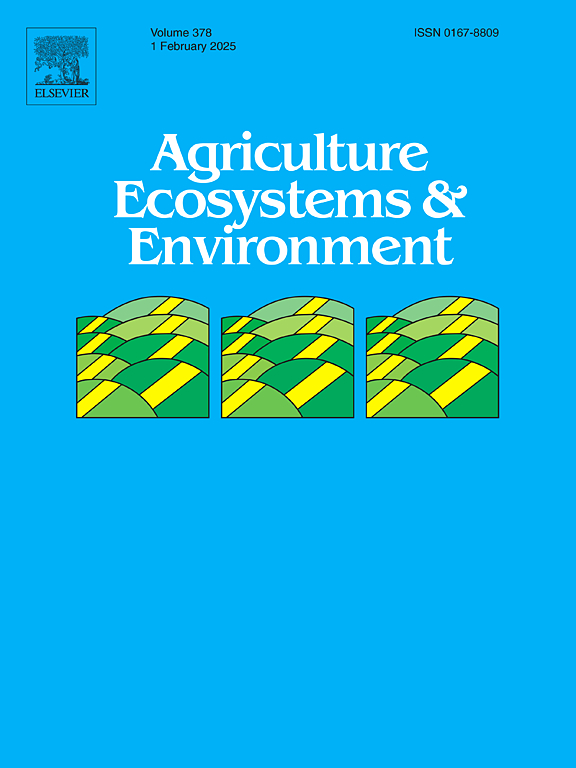Excluding livestock from farm dams enhances native biodiversity
IF 6.4
1区 农林科学
Q1 AGRICULTURE, MULTIDISCIPLINARY
引用次数: 0
Abstract
Amid a global biodiversity crisis and with over 50 % of the world's land dedicated to agriculture, solutions that enhance the biodiversity value of farmland are crucial. Fencing farm dams to prevent livestock access may provide numerous production and biodiversity benefits. However, we have limited information on the responses to fencing dams by various taxa, and its subsequent effect on community assemblages and ecosystem function. We investigated the impact of fencing farm dams on species richness, functional diversity, and community structure in a control-impact study in south-eastern Australia by comparing 20 fenced and 20 unfenced dams (40 dams total). We used a combination of in-person surveys, trail cameras, eDNA, and acoustic loggers to detect a wide range of fauna. We found significant differences in overall species richness, functional diversity and species composition between fenced and unfenced dams. Taxonomic groups including birds and mammals, and feeding guilds including carnivores and frugivores were more prevalent at dams that excluded livestock. Our results suggest that excluding livestock from farm dams preferentially benefits native species. At the species level, larger-bodied waterbirds such as dabbling ducks tended to prefer unfenced dams, while smaller woodland birds characteristic of nearby remnant woody native vegetation preferred fenced dams. We show that excluding livestock from farm dams has significant positive effects on biodiversity, ecosystem function and community structure.
将牲畜排除在农场水坝之外可以提高当地的生物多样性
在全球生物多样性危机中,世界上超过50% %的土地用于农业,提高农田生物多样性价值的解决方案至关重要。围栏农场水坝防止牲畜进入可能提供许多生产和生物多样性的好处。然而,关于不同类群对围坝的响应及其对群落组合和生态系统功能的影响,目前的研究还很有限。通过对澳大利亚东南部20座围栏和20座非围栏水坝(共40座水坝)的比较,研究了围栏农场水坝对物种丰富度、功能多样性和群落结构的影响。我们结合了现场调查、跟踪摄像机、eDNA和声学记录器来探测各种各样的动物群。结果表明,围坝与非围坝在总体物种丰富度、功能多样性和物种组成上存在显著差异。包括鸟类和哺乳动物在内的分类群体,以及包括食肉动物和食果动物在内的喂养行业,在不包括牲畜的水坝中更为普遍。我们的研究结果表明,从农场水坝中排除牲畜优先有利于本地物种。在物种水平上,体型较大的水鸟(如涉水鸭)倾向于选择不设防的水坝,而体型较小的林地鸟类(以附近残留的原生木本植被为特征)则更喜欢设防的水坝。研究结果表明,将牲畜排除在农田水坝之外对生物多样性、生态系统功能和群落结构都有显著的积极影响。
本文章由计算机程序翻译,如有差异,请以英文原文为准。
求助全文
约1分钟内获得全文
求助全文
来源期刊

Agriculture, Ecosystems & Environment
环境科学-环境科学
CiteScore
11.70
自引率
9.10%
发文量
392
审稿时长
26 days
期刊介绍:
Agriculture, Ecosystems and Environment publishes scientific articles dealing with the interface between agroecosystems and the natural environment, specifically how agriculture influences the environment and how changes in that environment impact agroecosystems. Preference is given to papers from experimental and observational research at the field, system or landscape level, from studies that enhance our understanding of processes using data-based biophysical modelling, and papers that bridge scientific disciplines and integrate knowledge. All papers should be placed in an international or wide comparative context.
 求助内容:
求助内容: 应助结果提醒方式:
应助结果提醒方式:


